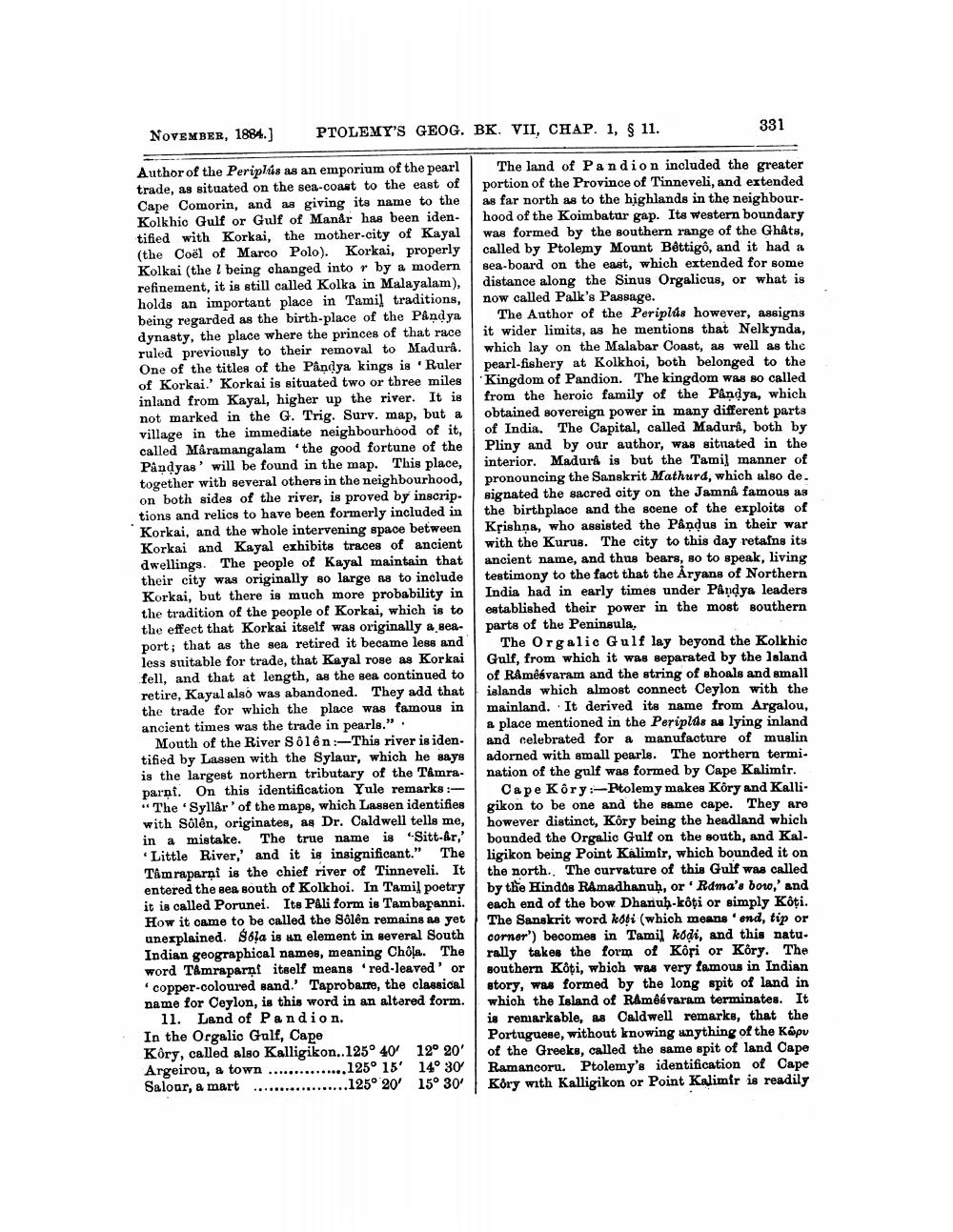________________
NOVEMBER, 1884.)
PTOLEMY'S GEOG. BK. VII, CHAP. 1, § 11.
331
Author of the Periplús as an emporium of the pearl trade, as situated on the sea-coast to the east of Cape Comorin, and as giving its name to the Kolkhic Gulf or Gulf of Manår has been identified with Korkai, the mother-city of Kayal (the Coël of Marco Polo). Korkai, properly Kolkai (the l being changed intor by a modern refinement, it is still called Kolka in Malayalam), holds an important place in Tamil traditions, being regarded as the birth-place of the Pandya dynasty, the place where the princes of that race ruled previonsly to their removal to Madura. One of the titles of the Pandya kings is 'Ruler of Korkai.' Korkai is situated two or three miles inland from Kayal, higher up the river. It is not marked in the G. Trig. Surv. map, but a village in the immediate neighbourhood of it, called Maramangalam "the good fortune of the Pandyas' will be found in the map. This place, together with several others in the neighbourhood, on both sides of the river, is proved by inscrip. tions and relics to have been formerly included in Korkai, and the whole intervening space between Korkai and Kayal exhibits traces of ancient dwellings. The people of Kayal maintain that their city was originally lo large as to include Korkai, but there is much more probability in the tradition of the people of Korkai, which is to the effect that Korkai itself was originally a seaport; that as the sea retired it became less and less suitable for trade, that Kayal rose as Korkai fell, and that at length, as the sea continued to retire, Kayal alsó was abandoned. They add that the trade for which the place was famous in ancient times was the trade in pearls.".
Mouth of the River Sôlên :-This river is iden. tified by Lassen with the Sylaur, which he says is the largest northern tributary of the Tamraparni. On this identification Yule remarks: "The Syllar' of the mape, which Lassen identifies with Sôlên, originates, as Dr. Caldwell tells me, in a mistake. The true name is Sitt-Ar,'
Little River, and it is insignificant." The Tâmraparņi is the chief river of Tinneveli. It entered the sea south of Kolkhoi. In Tamil poetry it is called Porunei. Its PAli form is Tambapanni. How it came to be called the Sölên remains as yet unexplained. $6ļa is un element in several South Indian geographical names, meaning Chóļa. The word Tamraparņi itself means 'red-leaved' or
copper-coloured sand.' Taprobarre, the classical name for Ceylon, is this word in an altered form.
11. Land of Pandion. In the Orgalic Galf, Cape Kôry, called also Kalligikon..125° 40' 12° 20' Argeirou, a town ............... 125° 15' 14° 30 Saloar, a mart ..................125° 20' 15° 30'
The land of Pandion included the greater portion of the Province of Tinneveli, and extended as far north as to the highlands in the neighbourhood of the Koimbatur gap. Its western boundary was formed by the southern range of the Ghâts, called by Ptolemy Mount Bêttigô, and it had a sea board on the east, which extended for some distance along the Sinus Orgalicus, or what is now called Palk's Passage.
The Author of the Peripids however, assigns it wider limits, as he mentions that Nelkynda, which lay on the Malabar Coast, as well as the pearl-fishery at Kolkhoi, both belonged to the Kingdom of Pandion. The kingdom was so called from the heroic family of the Pandya, which obtained sovereign power in many different parts of India. The Capital, called Maduri, both by Pliny and by our author, was sitnated in the interior. Madura is but the Tamil manner of pronouncing the Sanskrit Mathurd, which also de. signated the sacred city on the Jamni famous as the birthplace and the scene of the exploits of Krishna, who assisted the Påndus in their war with the Kurus. The city to this day retains its ancient name, and thus bears, so to speak, living testimony to the fact that the Aryans of Northern India had in early times under Pandya leaders established their power in the most southern parts of the Peninsula,
The Orgalie Gulf lay beyond the Kolkhic Gulf, from which it was separated by the Island of RAmêsvaram and the string of shoals and small islands which almost connect Ceylon with the mainland. It derived its name from Argalou, a place mentioned in the Periplas as lying inland and celebrated for a manufacture of muslin adorned with small pearls. The northern termi. nation of the gulf was formed by Cape Kalimfr.
Cape Kory:-Ptolemy makes Kóry and Kalligikon to be one and the same cape. They are however distinct, Kóry being the headland which bounded the Orgalic Gulf on the south, and Kal. ligikon being Point Kalimir, which bounded it on the north. The curvature of this Gulf was called by the Hindus Ramadhanuh, or Rama's boro,' and each end of the bow Dhanuh-köţi or simply Kôţi. The Sanskrit word koti (which means 'ond, tip or corner') becomes in Tamil kodi, and this natu. rally takes the form of Kori or Kôry. The southern Koti, which was very famous in Indian story, was formed by the long spit of land in which the Island of Raméévaram terminates. It is remarkable, as Caldwell remarks, that the Portuguese, without knowing unything of the Kapv of the Greeks, called the same spit of land Cape Ramancoru. Ptolemy's identification of Cape Kory with Kalligikon or Point Kalimir is readily




